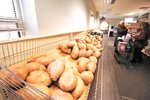The line was long this recent Tuesday at Westbay Community Action’s Marketplace food pantry as people of diverse ages and backgrounds filled shopping carts with fresh eggs, dairy products, …
This item is available in full to subscribers.
We have recently launched a new and improved website. To continue reading, you will need to either log into your subscriber account, or purchase a new subscription.
If you are a current print subscriber, you can set up a free website account by clicking here.
Otherwise, click here to view your options for subscribing.
Please log in to continue |
|





The line was long this recent Tuesday at Westbay Community Action’s Marketplace food pantry as people of diverse ages and backgrounds filled shopping carts with fresh eggs, dairy products, frozen foods, cereals, grains, canned goods and pretty much anything else one would need for nutritious meals.
Having met income eligibility criteria, everyone was getting their food for free.
And there to help was volunteer John Johnson, 82, a retired factory worker.
“It's satisfying because I'm giving something back,” said Johnson, who goes by the nickname “Papa John.”
Like the people he was assisting, Papa John is also a Marketplace patron. He and his wife live on Social Security and without Westbay, he said, they would face difficulties.
“Everything we get here is something we don't have to buy and that helps pay the electric bill, it helps pay the gas bill,” he said. “I’ve got critters, too, and you know, they have to eat, too. I’ve got cats and I’ve got chickens and it all helps.”
Those who rely on Westbay would agree, according to Johnson.
“We have all kinds of people come here,” he said. “We have people with five kids, six kids. I’ve got a couple of friends who are disabled and they’re coming here now because they just went into [public] housing and they’re having it rough, too.”
Johnson pointed out a woman moving through the line.
“She’s Russian,” he said, and her English is limited.
But she always expresses her gratitude, Johnson said, telling him, “Thank you very much, thank you very much, you’re a sweetheart.”
And that, he said, “makes my day,” as he has helped make hers.
Like other pantries and programs throughout Rhode Island, Westbay provides defense against food insecurity, which the U.S. Department of Agriculture defines as “the limited or uncertain availability of nutritionally adequate and safe foods, or limited or uncertain ability to acquire acceptable foods in socially acceptable ways.”
How pervasive is the problem?
Thirty-one percent of Rhode Island households “were food insecure and unable to afford adequate food” during a survey taken last spring by the Rhode Island Life Index, an initiative of Brown University's School of Public Health and Blue Cross & Blue Shield of Rhode Island. The COVID-19 pandemic, with its historic losses of life, health and jobs, has exacerbated the situation, as have dramatic increases in the costs of rent, fuel and grocery-bought food.
“Westbay’s food pantry provides food daily to over 80 households who are seeking emergency food,” Westbay Community Action president and CEO Paul Salera told Ocean State Stories. “These people that are coming in are the ‘underemployed’ or ‘low-wage earners’ who rely on us to give them a hand up on stretching their monthly budgets.”
Salera added: “Many people coming to our pantry are on fixed incomes, and more than 30% of households seeking food are over 60 years of age so the food we are providing is allowing these households to utilize money that would otherwise be spent on food to help pay other household bills to ensure that they can maintain independence in their homes.”
Westbay succeeds with support from individual donors, local businesses, and financial institutions; and with food received from food drives and donations from chains including Dave’s Fresh Marketplace, Target and BJ’s Wholesale Club. The largest source for Westbay, as for many others, is the Rhode Island Community Food Bank, which operates a 77,000-square foot facility in Providence.
Food insecurity knows no geographic, age, or racial or ethnic bounds, although disparities exist, with Rhode Island residents of color significantly more likely than whites to experience difficulties in finding and purchasing adequate, healthy food, according to the Rhode Island Community Food Bank’s 2022 Status Report on Hunger in Rhode Island.
The Status Report, which drew some of its findings from the Rhode Island Life Index, depicts a statewide crisis. Among the conclusions:
“These households ran out of food and didn’t have money to buy more, placing their children at risk of hunger,” the report declares. “The rate of food insecurity is even higher among families at the lowest rungs of the income ladder. The inability of so many low-income families to meet
their basic food needs has serious consequences, since poor nutrition adversely impacts children’s health, growth, and learning.”
During a visit to the Food Bank’s Providence headquarters, CEO Andrew Schiff brought Ocean State Stories through its massive warehouse, where food was being unloaded for sorting and delivery to pantries and programs. Twenty-four percent of its food is donated, with 32% purchased, and 44% coming from the U.S. Department of Agriculture. Like Westbay and many programs, the Food Bank also receives support from individuals and organizations.
Schiff is intimately familiar with the grim choices facing many Rhode Islanders.
“When you don't have adequate money to buy the food you need, you look for ways to stretch the dollars that you have,” he said. “And you can do that by buying less nutritious food that is low-cost. Families often tell us that they put the money they have in the household budget towards very, very basic items and they never have money for, for example, fresh produce. But fresh produce is the healthiest food you can eat.
“One of the misunderstandings that I think people have had is the idea that somehow low-income families don't know what to eat, that they need nutrition education. Education is a good thing, but low-income families are buying less expensive, less nutritionally good food because they just don't have the money” for pricier, more nutritionally sound food.
Faced with hunger or homelessness, Schiff said, families typically will sacrifice nutritious eating.
“You can't tell your landlord you're going to pay 80% of the rent,” he said. “They'll just evict you. But you can pay 80% for the food that you were planning to buy for your family. And that's what happens, particularly in the last weeks of the month.
“We find—over and over again—that's when demand for food pantries in Rhode Island really peaks, because people are running out of food, they're running out of government benefits that they have, and they’re running out of money.”
In their research on food insecurity, Dr. Amy S. Nunn, executive director of the Rhode Island Public Health Institute and a professor at Brown University’s School of Public Health, and her fellow scientists have demonstrated that a poor diet is a high risk factor for cancer, type 2 diabetes, obesity, and cardiovascular disease.
Where you live, they have established, is related to your ability to eat well.
Residents of “food deserts,” areas where nutritious food is unavailable or expensive, must make do with what they can find. Residents of “food swamps,” defined by the Centers for Disease Control and Prevention as “environments saturated with unhealthy foods because of the large numbers of corner stores and fast-food outlets in them,” face similar dietary danger.
Transportation challenges abound. Not everyone owns a car or knows someone who can provide a ride. Taxis and Uber are costly. Bus routes do not reach every pantry and meal site. People with limited mobility may be unable to leave where they live.
“Geography matters,” Nunn told Ocean State Stories. “Where you live affects whether you have access to healthy foods. Also, people's ability to get places transportation and cost. Those are the biggest determinants of whether or not people eat fruits and vegetables.
“It's not that people want to eat junk food all day. They may just not have access to or not be able to afford [healthy food]. And our research study has proved that people dramatically improve their eating behaviors if you make it cheap and easy.”
Enter Food on the Move, a mobile produce market operated by the Rhode Island Public Health Institute that brings fresh, low-cost vegetable and fruits to sites in Central Falls, Pawtucket and Providence. Customers using Supplemental Nutrition Assistance Program dollars, SNAP, receive a 50% discount.
One recent morning, Nkese Edem, 48, dropped by Food on The Move’s weekly market held at Charlesgate Senior Living Center on North Main Street, Providence. Program staff members had brought in food from their refrigerated truck and arranged it in a lobby. Shoppers had their choice of a large and culturally diverse selection that included kale, pineapples, tomatoes, peppers, mangoes, melons, ginger, red grapes, broccoli, avocados, bananas and much more.
Edem selected her food and paid for it at the checkout counter, where purchases are entered into the program’s database, a tool for reordering, refining offerings, and research.
“I don’t drive,” Edem said, “and you don’t want to be going all around the city” on foot or by bus looking for food. “And then, with prices going up and everything, you want to make sure it’s as easy as possible.”
Edem said she appreciates the health benefits of nutritious food, what with stories she’s heard of people “forty years old, 55 years old, having cardiac arrest, kidney problems, just all kinds of things and people dying young. You need as much good stuff as you can get.”
Good-tasting, too, according to Edem.
“I like it,” she said, smiling.
She did have a suggestion for Food on the Move.
“They could even expand,” she said. “They could do apple cider or apple juice. A lot of people would probably come in for that, too.”
Learn more about Westbay Community Action at https://westbaycap.org/
The Rhode Island Community Food Bank: https://rifoodbank.org/ The Rhode Island Public Health Institute: https://riphi.org/home/
Food on the Move: https://riphi.org/food-on-the-move/
Ocean State Stories is a new media outlet based at Salve Regina University’s Pell Center devoted to stories about issues of importance to Rhode Islanders. Story copyright 2023 Salve Regina University. Originally published at OceanStateStories.org
In the next edition, slated for publication on Feb. 15, we will be looking at food insecurity in Newport, northern Rhode Island, and Southside.
Comments
No comments on this item Please log in to comment by clicking here